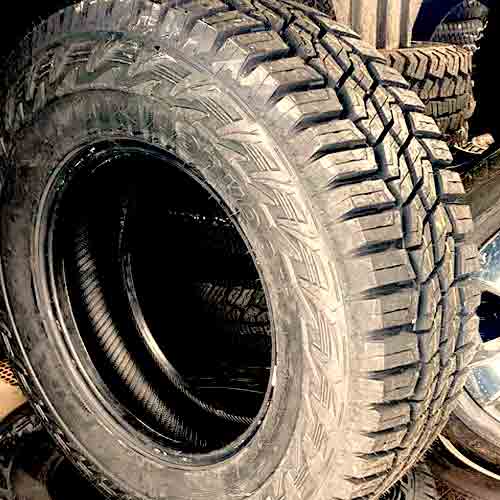The Hankook Dynapro XT may seem all-terrain, but it’s actually a little more aggressive. It comes in the rugged terrain category of tires, so it’s having a mixture of mud-terrain-like shoulder lugs, and relatively compacted up central section. Let’s take a closer look at it.

In my professional opinion as a tire engineer, the Hankook Dynapro XT is a great tire to have for paved roads (comparing other hybrids out there). It features above-average directional and lateral grip, fuel economy and tread life, and supplies you with amazing snow performance (ranked with 3PMSF). Though relatively, the tire could use a bump when it comes to grip off-road, especially on softer terrains, such as mud and sand.
Available Sizes
Starting with Hankook Dynapro XT, this tire has following specs.
- Sizes: 31 total sizes in 17 to 20″.
- Speed rating: R only.
- Load Rating: C to E.
- Weight: 45 to 77 lbs.
- Tread depth: /32″
- All have 3PMSF and M+S winter ratings.
- Warranty: 50k miles for all
Tread Design
The Hankook Dynapro XT is although a rugged terrain tire, gives you 4 conventional longitudinal ribs on its tread.

Starting from the outer ribs, here, the you see elongated shoulder lugs, with rectilinear siping in them.
They are very blocky, and are missing with traction scoops on their outer edges (not staggered).
Moreover, the sidewall lugs are also not thick enough, though they still provide decent biting off-road with running the tire with reduced air pressure.
The central section gets divided by wider longitudinal zigzag, where you see 2 ribs having paired up blocks.
These lugs have zigzag lateral slits (forming in-groove notches), full depth sipes, and sharp off-set edges to them.
Wet Performance
Let me save you some time. The Hankook Dynapro XT is not going to impress you when things get wet.
This is mainly because of it’s less effective siping structure. They are although full depth, they lack in flexibility and don’t have an interlocking structure (which is more efficient).
Basically sipes breath water particles in, so that the rubber can grip on the surface. And in case of Dynapro X/T the rectilinear sipes are too stiff to flex properly, whereas the tire’s harder rubber compound isn’t helping to that either.
Though the tire does pretty great in the hydroplaning department, as seen with both straight and curved aqua tests, where it shows outperforming float speeds (comparing others in the category).
Float speed for those of you who don’t know is just the maximum speed with which a tire can move over standing water without floating.
Highway Performance
Roads and pavements are usually not a place for aggressive tires, as they lack in terms of grip, and can’t offer decent stability a long with comfort.
Let’s look at some key factors majorly affecting the tire’s on-road traction.
Dry Grip
Grip on dry roads is essential and is primarily determined by the rubber-to-road contact. Simply put; the greater the contact, the better the grip.
While the Hankook Dynapro XT may not render as much rubber’s exposure compared to an average all-terrain tire, it still performs admirably in its category (of hybrids). The tire features two central ribs that, although spaced apart, have blocks running in pairs and are supported by reinforced foundations.
The longitudinal orientation of these ribs allows the tire to maintain better straight-line movement. This structural features contribute to decent braking distances, which directly evaluates directional or dry grip.
Dry Highway Handling
In terms of handling, the Hankook Dynapro XT performs reasonably well too, with a notably good steering response.
Its blocky shoulder lug design with minimal tread features on, connect with the road better while cornering, and its relatively lighter weight minimizes lug movement.
As the tire turns, the weight on it, gets shifted on sides, and as the Hankook XTs weight is not a lot relatively, (comparing others in its category), its blocks aren’t pushed that much, to bend against the road.
This bending basically causes under and over steering, resulting in improved overall handling, and is seen avoided on this tire a lot more.
Fuel Consumption
Both the composition/design of the tread and the tire’s weight significantly influence rolling resistance, which in turn impacts fuel consumption.
The tire’s weight and compound composition basically tells how much would the tread blocks want to move during braking or sudden cornering, producing heat and wasting energy.
And the tire design tell you about the lugs ability to contact with the road. For example on-road tires have longitudinally arranged blocks which roll (straight) on highways with much more ease compared to aggressive tires.
Considering both points we can easily see why the Hankook Dynapro XT is one of the most fuel efficient tires out there in its category of hybrids.
Not only it supplies you with a stable rubber compound, but you also get solid reinforced foundations underneath them, along with of course circumferential grooves.
Ride Comfort
While the Hankook XT tire’s stiffer compound may not be as effective at dampening bumps compared to other hybrid tires, its on-road stability and noise reduction efficacy still places it within the “comfortable” range.
The closed lug arrangement and stiffer compound provide a stable ride with superior steering responsiveness. And they also only allow limited air particles to strike around generating noise.
Though most of the noise this tire dampens, is by its pitch sequencing technology, where lugs have slightly different angles to them so that air particles hitting them could form different types of tones, that would later on try to cancel out each other.
Winter Performance
The tire’s suitability for winter driving is evaluated based on its performance on snowy and icy surfaces, including stability, control, and acceleration effectiveness.
In all of these aspects, the Hankook Dynapro XT performs well, which is why it has a 3-peak mountain snowflake rating, unlike most of the hybrid tires you see out there.
The tire has more biters and its interlocking sipes trap snow particles more effectively, creating better snow-to-snow contact for optimal winter performance.
To give you a ball park, the tire comes in the top 5 best hybrids when it comes to snow performance. And if you are wondering, I ranked Mickey Thompson Baja Boss (review) is leading the list.
Mud Performance
Compared to other tires, the narrower grooves of the Hankook Dynapro XT result in limited clay evacuation and reduced traction in muddy conditions.
The tire’s lugs are not adequately spaced, and because they are connected longitudinally, thick mud cannot easily escape so easily, particularly sideways. I am saying this whilst, of course, comparing with other rugged terrain tires out there.
Furthermore, the Dynapro XT lacks staggered shoulder lugs with mud scoops, limiting its ability to provide effective paddling and shoveling abilities.
Sand Traction
On sand, a lightweight tire with a softer compound is preferable. These characteristics allow it to float better and dig less, especially when the air pressure is reduced (which is must for almost all kinds of sandy terrains).
A larger contact patch helps the tire float better, while a lighter structure prevents it from sinking into this type of soft ground.
These variables above, can be used to explain why the Hankook Dynapro XT does so well here, particularly during incline traction tests.
Compared to other hybrids, the tire does not weigh that much, and features a smoother outer edges (on shoulders, as they are not serrated). So its not that susceptible to sinking as it rolls.
Though the tire could use some sidewalls lugs, even though they still help in overall contact patch with lowered air pressure PSI.
Rock Climbing Abilities
A tire suitable for rocky terrains should have a flexible tread with bendable blocks or lugs, strong grip in all directions for stability, and yes, sturdy sidewalls to guard against sharp punctures (as it’s where most punctures happen).
Although the Hankook Dynapro XT lacks a significant number of biting edges, it does feature wide grooves, angled in multiple directions, allowing for ample grip and effective climbing from all sides.
Additionally, the tire is equipped with durable 3-ply sidewalls and thick lugs on top, providing all the toughness you need.
Despite the tread having a stiffer compound, these lugs flex with reduced air pressure and add to overall tire’s climbing abilities.
Conclusion
The Hankook Dynapro XT is a versatile off-road tire with moderate performance across various terrain types.
While its tread life, comfort, and winter traction may not be exceptional, the tire performs well on rocks and sand.
However, it might not be the best option for mud traction.
Though I am really impressed with how this tire performed on roads/pavements, in both wet and dry environments. You get amazing traction values, and a very quiet ride with these tires.
Overall, it remains a solid choice for drivers seeking off-road capabilities with a reasonable balance between comfort and performance.